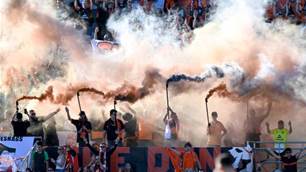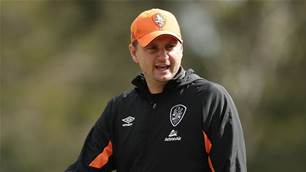THE fall of the former North Queensland Fury players...
Now looking to regain full fitness, after a short stint in the Illawarra Premier League, Casey says he’s aiming to get back into playing full-time. However, the former Sydney FC attacker says he needs to concentrate first on getting past the niggling injuries that have affected him over the past few seasons.
“I just want to get my body right; I have been struggling with injuries on and off for a while and I need to get the confidence in my body back,” says Casey. “I don’t think the A-League is out of the question for me, I am only 25, but my main priority is to look after my young daughter and do what is right by my family.”
Many of the players say a move back to the A-League or into other professional leagues could have been made easier had FFA kept them informed regarding the likelihood of the club surviving. Grossman says the players were totally in the dark, with most trying to keep positive about the club’s survival prospects throughout the season. “We never heard anything from FFA. The only indications we heard from FFA were what we heard through the papers,” says Grossman. “The only news we got was from the PFA [Professional Footballers Association] the day before [FFA announced the club would fold] saying there was a press conference being held in Townsville the next day and they were 99 per cent sure the Fury was going to be gone.”
Grossman says this made things more difficult as other options were put on hold as most players’ preference was to remain at the Fury. “The majority of people who were up in North Queensland wanted to help the club succeed and wanted to stay for the long term, so you didn’t really want to look at other places. If they had given us a heads-up it would have helped a lot of people avoid this situation.” With a lack of information from the governing body, Grossman says the players were reliant on information coming from the club itself. Desperate to continue into the future, Grossman said the club was doing everything in its power to survive and was therefore confident of remaining in the A-League. “Rabieh [Krayem, Fury CEO] was coming in and saying we are going to be here next year and he was extremely positive,” says Grossman.
Ham says FFA failed to take into account the difficulty players faced in finding a new club whilst not being in the shop window of the A-League, and should have kept the players more informed. “We could have made plans for our future much earlier and maybe secured another gig somewhere with the backing as a pro footballer instead of looking for a club as a non-professional,” he says.
Former Fury defender Brett Studman agrees, saying FFA should have taken into account the need for players to get their playing futures sorted as early as possible. “It was rubbish, the way everything was dealt with. You realised they had no intention of keeping the club afloat.”
Studman is now exploring options in Asia after starring in the NSW Premier League for Sydney Olympic. He says FFA was not aware of the impact its decision would have on the lives of the players. “It is really tough to get back into the A-League now as there are fewer opportunities. You have to go overseas and try to make a living there.”
Whilst the demise of the Fury had a major impact on all the lives of its ex-players, they were all equally concerned with the effect it would have on the region. With no professional football team within 1,300 kilometres of Townsville it is highly likely a generation of talented young players will be lost to rival codes such as Rugby League which can provide a pathway to the top level in Australia.
Having grown up in North Queensland, Ham knows better than most what effect the Fury’s demise will have on the sport in the region. “I know how dominant Rugby League is in the area. Finally we were making inroads with football up there and it has been taken back 20 or 30 years due to the decision,” says Ham. “If you kick these supporters in the guts enough they will turn away from the game forever and not look back, unfortunately FFA have done that and I think professional football in the north is dead.”
Having stayed behind in Townsville after the end of the Fury to play for Queensland State League club the North Queensland Razorbacks, Grossman says a difference in the locals’ appetite for the sport was already noticeable. “The level of enthusiasm in the kids up there dropped massively as they no longer have anything to aim towards,” says Grossman.
Trying to provide a pathway through his academy in Townsville, Gareth Edds says there is still enthusiasm for the sport, but few speak of the A-League. “I have kids that come to my academy that wouldn’t wear a Fury shirt because they don’t want to hurt my feelings and to be honest there is not much talk about the A-League. No kids ever come in and say did you see this? Did you see that?”
With people like Edds committed to football in North Queensland the game may live on. However, for many ex-Fury players and fans the death of their club ended their association with football and the game is no longer the same, and unfortunately neither are their lives. Football is not a matter of life or death but the Fury’s demise shows that life without it can be far from easy.
This article appeared in the February 2012 issue of Australian FourFourTwo magazine. To buy back copies of this issue call 03-8317-8121 with a credit card to hand.
The current edition of Australian FourFourTwo has just gone on sale in newsagent across the country, or you can subscribe here
Related Articles

A new era is unfolding at Brisbane Roar

Brisbane coach slams 'one rule for us, one rule for AFL, NRL'













